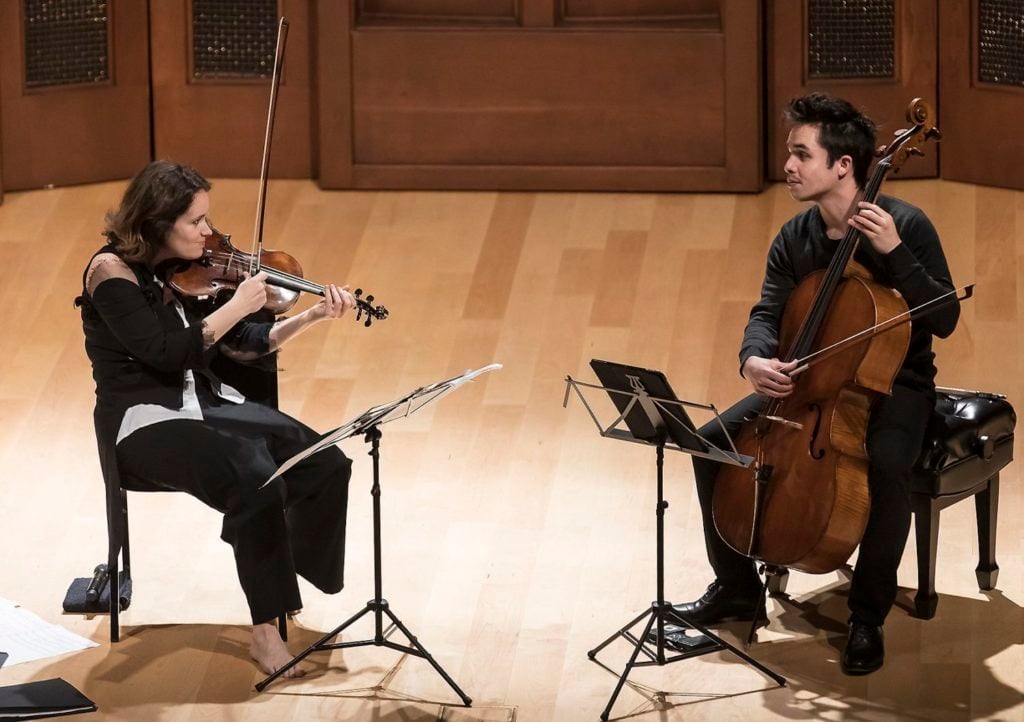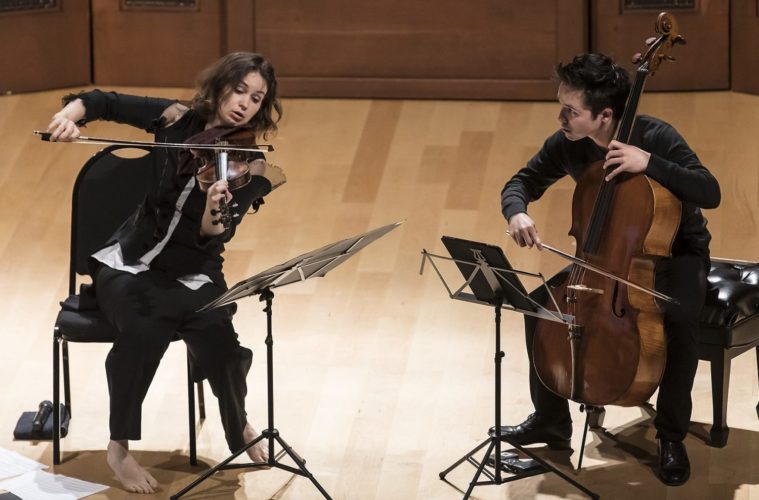Patricia Kopatchinskaja is one of the world’s great violinists — bold and daring while other musicians are cautious and bound by tradition — but she had never performed in Los Angeles until April 2019, when she swept through town for two astonishing yet diametrically opposed concerts. At Disney Hall, she completely demolished Tchaikovsky’s Violin Concerto, eschewing reverential duplication by radically reworking the piece with an awe-inspiring vibrancy. At Getty Center, Kopatchinskaja stood in a bathtub as she and local pianist Gloria Cheng untangled arty experiments by John Cage, Sofia Gubaidulina and La Monte Young in a brilliantly mad and difficult performance as part of Fluxus Festival.
The Moldovan violinist made a grand return to the West Coast in an intimate chamber recital on Saturday night, January 25, at Hahn Hall in Montecito, in her only Southern California appearance on her current tour with American cellist Jay Campbell. The duo’s unusual program spanned a thousand years, from “Alleluia” from Winchester Troper (circa the 11th century) to Én-kör III, a new work that was written specifically for Kopatchinskaja and Campbell by Hungarian composer Márton Illés and commissioned by UCSB Arts & Lectures.
The two pieces were juxtaposed at the beginning of the concert. “Alleluia” felt curiously timeless as Campbell pulled out high notes that didn’t sound like a cello. In fact, the seamless way Campbell and Kopatchinskaja wove their parts together made it seem at times as if they were playing a pump organ, harmonica and accordion, and their instrumental arrangement was simultaneously pastoral and haunting.
That subtle, trancelike spell was contrasted by Illés’ Én-kör III, which started immediately with an aggressive intensity. Kopatchinskaja initiated a series of muted runs and squeaky lines that were riven with Campbell’s ominous cello undercurrents. The violinist dug out a frenetic array of short, squiggly, scratching and scraping figures with fast, frantic slides up the fingerboard. The compendium of novelty sound effects and abrupt, impatient riffs sometimes evoked the Looney Tunes spirit of Carl Stalling. At one point, Kopatchinskaja’s violin paused momentarily during a rare quiet point before pouncing into action like a cat and chasing Campbell’s line, which was followed by another furious and harrowing interaction of knotty strings.
The duo played in front of a sold-out, well-heeled crowd amid the resonant acoustics of the elegant hall, which is situated just above the beach and is part of the Music Academy of the West campus in Montecito. Much of the audience was already familiar with Kopatchinskaja after she served as music director of the Ojai Music Festival down the coast in June 2018. Jack Quartet’s Campbell, on the other hand, impressed a local crowd at Disney Hall in November 2019, when he and John Adams co-curated an interesting Green Umbrella program of new compositions for cello. At Hahn Hall, both musicians were dressed in black, and as usual Kopatchinskaja defied traditional formality by performing barefoot.
The musicians followed Illés’ piece with excerpts from another modern work, German composer Jörg Widmann’s 24 Duos for Violin and Cello. Here Campbell demonstrated finesse and a rich, beautiful tone as he wended his way through the piece’s mix of nursery rhyme–like melodies and Kopatchinskaja’s slices of keening violin. Widmann’s composition was alternately lyrical and angular as the musicians rumbled through the work’s twists and turns. Kopatchinskaja brandished her bow triumphantly as if she were holding a sword.
Then the pair went back in time to the 17th century for a selection from English composer Orlando Gibbons’ Fantasia. This interlude was courtly and melodious, and Kopatchinskaja’s delivery was playfully eloquent with a hint of mournfulness. Campbell and Kopatchinskaja’s interplay was even more gorgeous on Maurice Ravel’s Sonata for Violin and Cello. The initial melodies folded over themselves like layers of leaves, and both string musicians wrung out exquisite tones before the first movement faded out with a sublimely delicate whisper of violin. Campbell’s somber cello parts became bolder and more jagged in the second movement, and the music reached such a delirious peak of intensity that it brought Kopatchinskaja out of her seat to stand up with a sudden, swaggering flourish.
In Ravel’s slower third movement, Campbell unwound slow, spare, low-key lines before Kopatchinskaja’s violin slipped in and the mood became more urgent. Campbell’s cello moved easily from higher parts to satisfyingly resonant lows before subsiding into a soft, breathtaking silence.

Patricia Kopatchinskaja and Jay Campbell (photo by David Bazemore)
After intermission, the musicians struck up Iannis Xenakis’ Dhipli Zyia for Violin and Cello, in which anxious uptempo passages were intercut with more beautifully restrained moments. Guillaume De Machaut’s Ballade 4 was slower and more formal, imbued with a churchy reverence and spaciousness infused with melancholy. György Ligeti’s Hommage à Hilding Rosenberg was a brief, shadowy aside with the strings smearing together moodily.
The concert closed with a magnificent performance of Zoltán Kodály’s Duo for Violin and Cello, Op. 7. During the course of the roughly 25-minute piece, Kopatchinskaja’s faint violin signals grew stronger, entered dark passageways and crossed icy landscapes as Campbell’s cello surrounded her parts with a thicket of thick cello branches. Kopatchinska’s playing ranged from muted plucking to stirringly beautiful louder sections and eerily alien high notes. Out of a spacious and lingering pool of sadness, Kopatchinskaja’s violin suddenly stabbed like ice picks before giving way to desolate softness. Macabre, lonely spaces were lit up by sweet shivers of violin and a deep, dark uprooting of cello. As the intensity built, Campbell’s bow became increasingly shredded. Near the end, Kopatchinskaja became so worked up that the music literally pulled her out of her chair. That, in turn, pulled the audience out of their seats for a well-deserved standing ovation.
The musicians encored with an interesting pizzicato arrangement of Carl Philipp Emanuel Bach’s Presto in C minor, which was originally written for keyboard. Kopatchinskaja and Campbell put down their bows, and their muted plucking was as delicate and soft as snowfall, the notes scampering stealthily across the stage like mice. After the dynamic shifts of Kodály’s piece, Presto was a more subdued contrast, the merry melody sparkling like fireflies at night.
Advertising disclosure: We may receive compensation for some of the links in our stories. Thank you for supporting LA Weekly and our advertisers.

